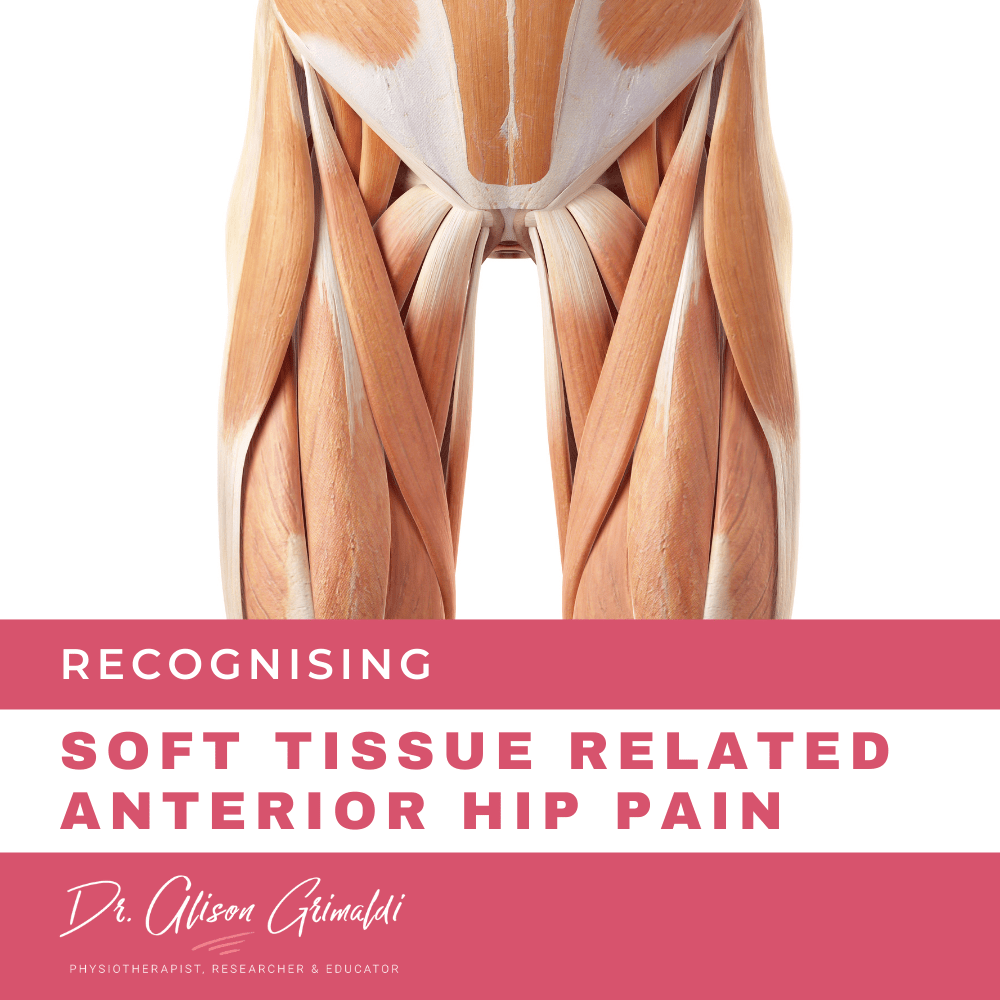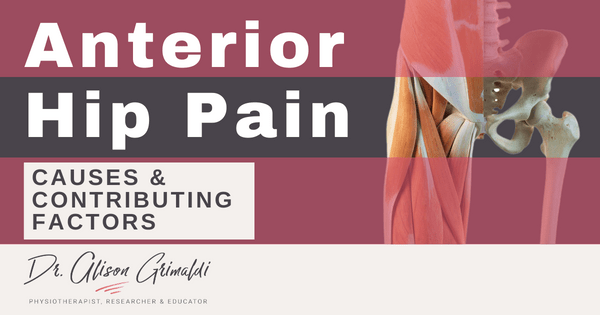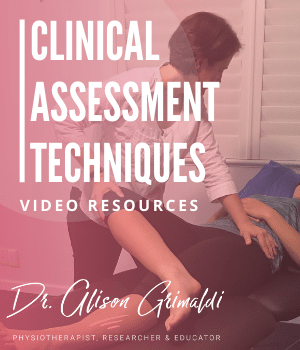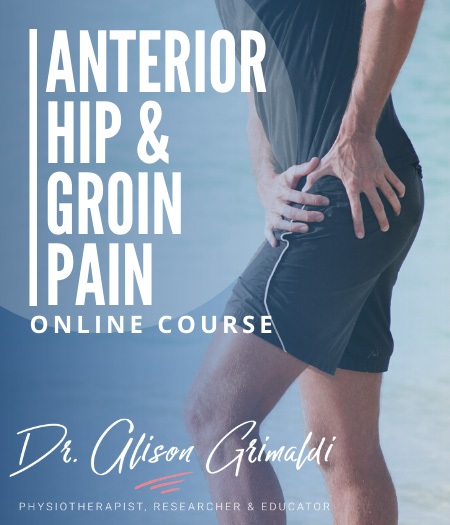Differential Diagnosis of Anterior Hip Pain – Soft Tissue

So far in this 4 part blog series on differential diagnosis of anterior hip pain, we have explored joint related anterior hip pain and bone related anterior hip pain. Today we move onto soft tissue related anterior hip pain. When a patient presents with anterior hip pain that is most aggravated by dynamic function involving some form of hip flexion action, soft tissue related anterior hip pain should be a priority focus of the differential diagnosis.
Can't make the workshop? Do the Online Course

Soft Tissue Sources of Anterior Hip Pain
At the anterior hip there is a confluence of soft tissues, with a number of muscles, tendons and attachments overlaid in a relatively small area. The sartorius and rectus femoris muscles sit most superficially at the anterior hip, although the rectus femoris emerges from a couple of deeper sites of origin.
The tensor fascia lata sits anterolaterally and although it contributes to hip flexion, will not be discussed in this blog as pain associated with this muscle is usually more lateral. Similarly, the anterior adductors also contribute to hip flexor function but adductor related pain presents more medially. Deep at the anterior hip we have the iliopsoas (iliacus and psoas major) and iliocapsularis muscles, and beneath the iliopsoas sits the psoas or iliopectineal bursa.

A review of origins, insertions and actions of the musculature that may contribute to soft tissue related anterior hip pain
For an accurate differential diagnosis of soft tissue related anterior hip pain, it is important to be aware of the functional anatomy of the region including origins, insertions and actions of the local musculature. Area of pain and sometimes tenderness, together with response to specific pain provocation tests placing active and or passive stress on different tissues will increase or reduce likelihood of each structure contributing to local nociception. You can review the detail below.

The importance of history and mechanism of injury in the different diagnosis of soft tissue related anterior hip pain
Taking a thorough history and stepping through any mechanism of acute injury can provide critical clues in the differential diagnosis of anterior hip pain. Soft tissue related anterior hip pain may develop subsequent to an acute overload, more gradually due to cumulative overload, after a surgical procedure or related to underlying joint conditions or infective processes.
1. Anterior hip pain related to acute overload of the hip flexors
The rectus femoris and iliopsoas complex are the most commonly injured hip flexor synergists (see pie graph),4 so a history of acute physical overload of the hip flexors would increase the likelihood of a source of nociception within these muscles. The mechanism of overload may further influence the relative likelihood of injury of rectus femoris versus the iliopsoas. Serner and colleagues4 determined that rectus femoris was much more likely to be injured in kicking or sprinting, while iliopsoas was interestingly more likely to be injured during a rapid change of direction task. Area of pain and physical testing add other key information.

2. Anterior hip pain related to cumulative overload of the soft tissues
Soft tissue related anterior hip pain may also develop over many months, years or even decades, associated with cumulative overload at the anterior aspect of the hip. This might be related to high volume dynamic hip flexion tasks with inadequate muscle recovery, or to habitual postures, movement patterns or task-specific hip extension loads. Excessive hip extension loads will increase compression of the iliopsoas against the underlying joint and bony structures. The rectus femoris tendons of origin will also be exposed to compression and traction in hip extension, with implications for overload of the capsular attachment or in adolescents, the bony apophysis.
Extra-articular impingement of the iliocapsularis and most proximal region of the rectus femoris may also occur in positions of deep hip flexion (e.g., a deep squat), between the anterior inferior iliac spine (AIIS) and the femoral neck.5 AIIS impingement is most common in those with a past history of ‘hip flexor’ injury, apophysitis or avulsion in adolescence.5
3. Iatrogenic mechanism for post-operative anterior hip pain
The most common mechanisms for iatrogenic anterior hip pain are related to total hip arthroplasty.
a. Iliopsoas impingement after total hip arthroplasty
One of the most common reasons for anterior hip pain following total hip replacement, is impingement of the iliopsoas against the underlying prosthesis. This can be quite debilitating and distressing for the patient. You can read much more about this in one of my previous blogs here.
b. Metallosis and the psoas bursa
Metallosis is a complication of some metal-on-metal hip prostheses. Metal debris may be found in the psoas bursa which often communicates with the hip joint. This may result in pain and other local sequalae, together with systemic toxicity in some individuals.6
4. Arthrogenic mechanism for soft tissue related anterior hip pain
Soft tissue sources of nociception may also develop in association with underlying hip joint pathology. Joint processes, particularly inflammatory conditions resulting in effusion, may result in inhibition or facilitation of muscle excitability. This is most likely to influence the periarticular muscles including the iliacus and iliocapsularis. Pain may develop due to inhibition, atrophy and subsequent reduction in load capacity, or muscle fatigue and overload associated with protective spasm.
5. Infective process underlying soft tissue related anterior hip pain
Relatively uncommon but not to be missed - psoas bursitis or an iliopsoas abscess arising from an infective process. An iliopsoas abscess is an infection that invades the iliacus or psoas muscle bellies, the most common pathogens being Staphylococcus aureus and tuberculosis. The onset is insidious, usually with no history of mechanical overload. Anterior hip and/or lower abdominal pain on active hip flexion are typical, with back pain also common particularly with a psoas major abscess. At their most acute, patients will present with fever and a limp, but others may present with fatigue and low-grade pyrexia. These symptoms may not be readily reported to an allied health professional, so further questioning is warranted where there is suspicion of a process that is not mechanical in nature. Suspicion should increase in those who are immunocompromised and/or have other gastrointestinal conditions or symptoms (Crohn’s disease, appendicitis, ulcerative colitis, diverticulitis, colorectal carcinoma, urinary tract infection).7
KEY IDENTIFIERS OF SOFT TISSUE RELATED ANTERIOR HIP PAIN
Anterior hip pain is more likely to be related to the soft tissues if:
- the pain is in the mid to lateral inguinal region
- aggravation of anterior hip pain is associated with
a. dynamic function that involves concentric or eccentric loading of the hip flexor musculature
b. stretch into hip extension +/- knee flexion - pain usually eases with rest
Ask further questions about general health in those with no clear mechanical history, to ensure infective processes within the soft tissues are not missed.
We are now three-quarters of the way through our differential diagnosis of anterior hip pain - joint related anterior hip pain, bone related anterior hip pain and now soft tissue related anterior hip pain. In the last instalment next month we will be completing the series with nerve related anterior hip pain. If you want to make sure you don't miss the remaining information, sign up to my newsletter or favourite the blog page and drop by next month.
Are you after more detail about anterior hip pain conditions, their pathoaetiology, assessment and management? You'll find plenty of evidence-based information and clinical pearls in my Anterior Hip & Groin Pain course. Or join the video library for access to a growing techniques library of clinical tests and exercises.
Another great Anterior Hip Pain blog

Anterior Hip Pain: Causes & Contributing Factors
Adequate consideration of individual causes and contributing factors is important for best outcomes.
Sign up to our newsletter to receive updates on upcoming courses, news and special offers.
References
- Yoshio, M., Murakami, G., Sato, T., Sato, S. and Noriyasu, S., 2002. The function of the psoas major muscle: passive kinetics and morphological studies using donated cadavers. Journal of Orthopaedic Science, 7(2), pp.199-207.
- Retchford, TH., Crossley. KM., Grimaldi, A., Kemp, JL., Cowan, SM., 2013. Can local muscles augment stability in the hip? A narrative literature review. Journal of Musculoskeletal and Neuronal Interactions, 13(1) pp.1-12.
- Lawrenson, P., Vicenzino, B., Hodges, P., Crossley, K., Heerey, J. and Semciw, A., 2020. Pericapsular hip muscle activity in people with and without femoroacetabular impingement. A comparison in dynamic tasks. Physical Therapy in Sport, 45, pp.135-144.
- Serner, A., Weir, A., Tol, JL., Thorborg, K., Roemer, F., Guermazi, A., Yamashiro, E., Hölmich, P., 2018. Characteristics of acute groin injuries in the hip flexor muscles - a detailed MRI study in athletes. Scandinavian Journal of Medicine in Science and Sports, 28(2), pp.677-685.
- Carton, P., Filan, D. 2016. Anterior Inferior Iliac Spine (AIIS) and Subspine Hip Impingement. Muscles, Ligaments and Tendons Journal, 6 (3), pp.324-336.
- Algarni, A., Huk, O. and Pelmus, M., 2012. Metallosis-induced Iliopsoas Bursal Cyst Causing Venous Obstruction and Lower-limb Swelling After Metal-on-metal THA. Orthopedics, 35(12).
- Shields, D., Robinson, P. and Crowley, T., 2012. Iliopsoas abscess – A review and update on the literature. International Journal of Surgery, 10(9), pp.466-469.





